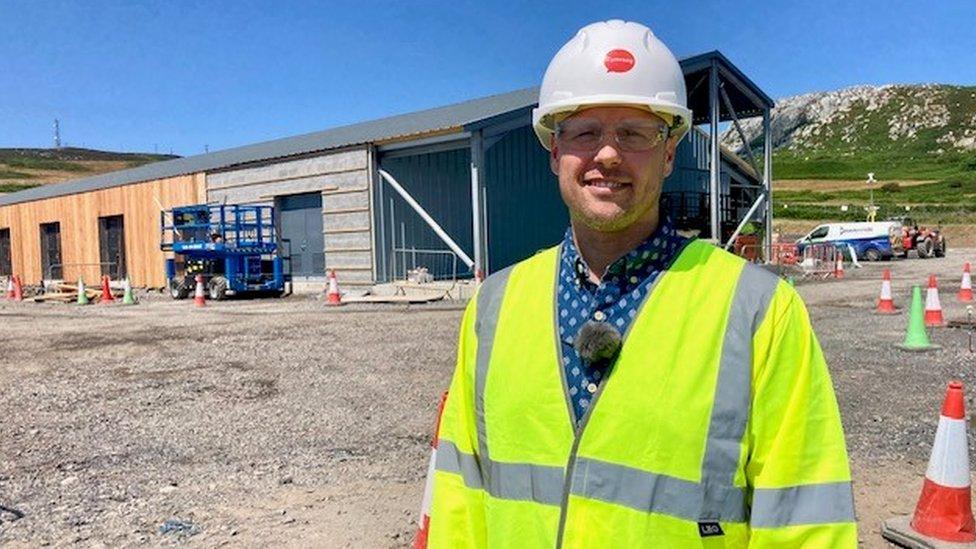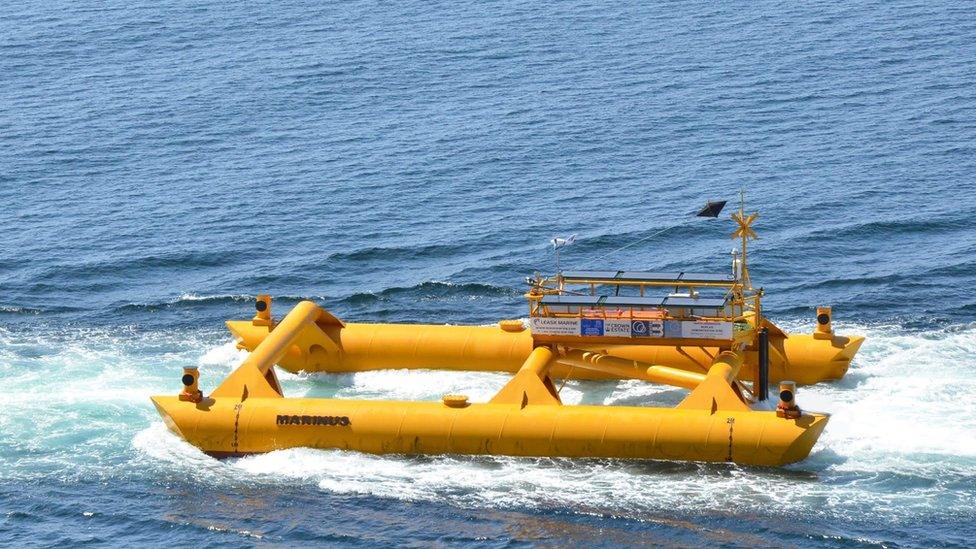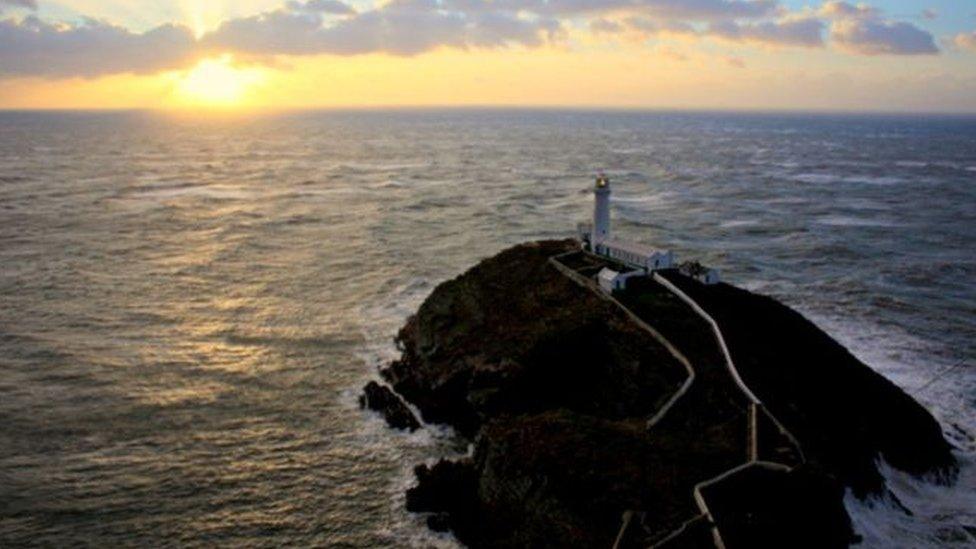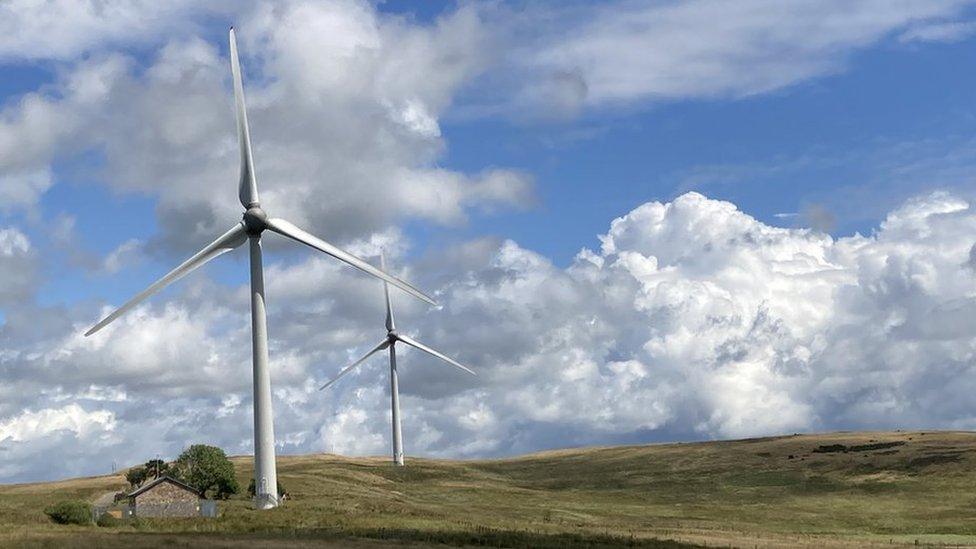Morlais tidal energy: 'World-leading' buoy protects wildlife
- Published

The main focus of the work is to trial visual data collection methods and analyse what is gathered around turbines
A high-technology buoy helping to protect sea wildlife at a massive north Wales tidal energy scheme is "leading the world," say its developers.
It trials data collection methods and analysis, and assists the team in learning more about creatures such as dolphins and porpoises off Anglesey.
Environmental groups have voiced concerns in the past at the possible effect on wildlife of the Morlais plan.
Organisers say data will help determine future development in the zone.
The knowledge will also be shared with other tidal energy projects around the world.
The environmental monitoring buoy is equipped with data collection technology, including surface infrared and red-green-blue (RGB) cameras, as well as underwater RGB cameras and wind speed measurements.
It will give researchers information about the feeding patterns and movements of fish and other sea creatures, said Dafydd Gruffydd, managing director of Menter Môn, the group running Morlais.

The buoy will gather environmental data and help to safeguard wildlife in the sea
"That will then inform us when we do actually deploy the devices, what impact - if any - there will be on the wildlife off the coast here.
"The technology we are using as part of this project is cutting edge and the research will be key to the growth of tidal energy worldwide."
As part of the work, bodies including Natural Resources Wales and the North Wales Wildlife Trust are providing advice on marine mammals and birds, as well as fish.
RSPB Cymru is also helping with shore-based seabird monitoring measures.
'We want to continue to learn'
The buoy is part of the Marine Characterisation Research Project (MCRP), whose manager Clare Llywelyn, described the work as "world-leading research" amid a "lack of evidence within the tidal stream energy industry".
"We're quite confident that there won't be any impact on marine wildlife in the area," she said.
"But we want to continue to learn. It just means that the next stage of the development, the deployment of the turbines, won't go ahead until we're certain there won't be any significant impact.

"We want to make sure that we're doing everything we can to safeguard marine wildlife," says project manager Clare Llywelyn
"We want to make sure that we're doing everything we can to safeguard marine wildlife in this area - it's really important to Menter Môn as an environmentally sensitive site.
"We've done extensive impact assessments in the past to understand more about the wildlife and the monitoring will continue throughout the lifetime of the project.
"It's really exciting. The MRCP findings will be made available to similar tidal stream energy projects in Wales and globally to help really promote this sector."
In March 2022, the Morlais project secured £31m of funding in what was the last large grant from the EU's regional funding program for the scheme.
Once fully operational, the scheme will be able to provide clean power for more than 180,000 homes.

"As a local person, living on Anglesey, it's fantastic," says Gareth Roberts, of the Morlais team
Gareth Roberts, Morlais's operational leader, said: "The idea is that a developer - you can compare it to a caravan site - that they bring their device, plug it in and they get connected straight into the grid.
"We've put all the infrastructure in place, we've got the buildings, we've got the cables.
"It's running all the way back to the grid connection at Parc Cybi. So the only thing the developer has to do is bring their equipment, put it in the sea, run the cables and connect to our system."
As the "biggest site of its kind in the world", Mr Roberts said the project would ensure that "Anglesey is definitely on the map" in terms of tidal energy.
"As a local person, living on Anglesey, it's fantastic," he adds.

Developers say the buoy is "leading the world"
He said there were "a number of developers around the world who have a vast interest in what we're doing here".
When this phase of the MCRP is complete, work is expected to begin on the installation of turbines in the sea in the Morlais zone in 2026.
Environmental monitoring will continue through the lifetime of the project to ensure the safeguarding of marine mammals and seabirds.
Related topics
- Published22 March 2022

- Published19 October 2021

- Published11 August 2020
